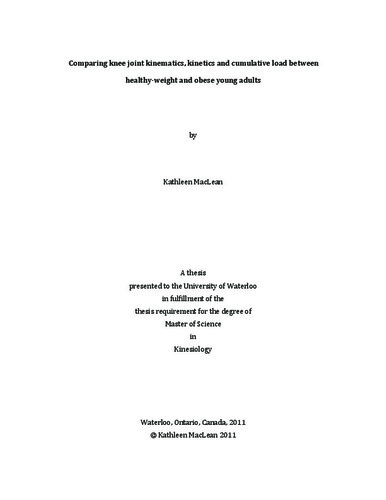| dc.description.abstract | One of the most poorly understood co-morbidities associated with obesity is the pathway to osteoarthritis of the knee. To implement appropriate preventative strategies, it is important to explore how obesity is a causal factor for osteoarthritis. The present research compared the kinematics and kinetics of a group of young obese, but otherwise healthy, adults to a group of young, healthy-weight adults, in an attempt to identify mechanical abnormalities at the knee during walking that may predispose the obese to osteoarthritis of the knee.
Optotrak motion capture (Northern Digital Inc. Waterloo, Ontario) and a forceplate (AMTI OR6-7, Advanced Mechanical Technology Inc, Watertown, MA) were used to measure ground reaction forces and moments of 16 participants – 8 obese and 8 sex-, age- and height-matched healthy-weight – to analyze knee joint kinematics and kinetics at three walking speeds. Participants wore an accelerometer (ActiGraph GT3X, Fort Walton Beach, USA) for seven days to measure daily steps counts. Dependent t-tests were performed to determine group differences in ground reaction forces, knee angles and knee moments, as well as knee adduction moment impulse and cumulative knee adductor load (CKAL).
The obese group walked at a significantly slower self-selected speed (p=0.013). While not statistically significant, the obese group did present with a more valgus mean dynamic knee alignment than the health-weight group. A significantly greater maximum abduction angle (p=0.009) and smaller minimum knee flexion angle at heel contact (p=0.001) was found in the obese group. A significant difference was found in the peak medial rotation moment in the transverse plane (p=0.003). A greater stance duration lead to a significantly greater knee adduction moment impulse (p=0.049) in the obese group. While significant group differences were not found in the steps per day, the obese group had a significantly greater CKAL (p=0.025).
Obese young adults with healthy knees demonstrated a gait pattern of reduced medial knee joint compartment loading through greater knee abduction, medial knee rotation and a slower walking speed compared to matched controls. The ramifications of gait modifications on long-term musculoskeletal health remain unknown, but compensations may lead to increased risk of osteoarthritis of the knee. | en |

